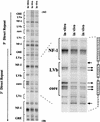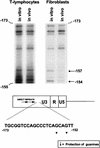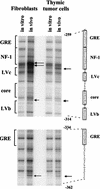In vivo footprinting of the enhancer sequences in the upstream long terminal repeat of Moloney murine leukemia virus: differential binding of nuclear factors in different cell types
- PMID: 9765441
- PMCID: PMC110313
- DOI: 10.1128/JVI.72.11.8961-8970.1998
In vivo footprinting of the enhancer sequences in the upstream long terminal repeat of Moloney murine leukemia virus: differential binding of nuclear factors in different cell types
Abstract
The enhancer sequences in the Moloney murine leukemia virus (M-MuLV) long terminal repeat (LTR) are of considerable interest since they are crucial for virus replication and the ability of the virus to induce T lymphomas. While extensive studies have identified numerous nuclear factors that can potentially bind to M-MuLV enhancer DNA in vitro, it has not been made clear which of these factors are bound in vivo. To address this problem, we carried out in vivo footprinting of the M-MuLV enhancer in infected cells by in vivo treatment with dimethyl sulfate (DMS) followed by visualization through ligation-mediated PCR (LMPCR) and gel electrophoresis. In vivo DMS-LMPCR footprinting of the upstream LTR revealed evidence for factor binding at several previously characterized motifs. In particular, protection of guanines in the central LVb/Ets and Core sites within the 75-bp repeats was detected in infected NIH 3T3 fibroblasts, Ti-6 lymphoid cells, and thymic tumor cells. In contrast, factor binding at the NF-1 sites was found in infected fibroblasts but not in T-lymphoid cells. These results are consistent with the results of previous experiments indicating the importance of the LVb/Ets and Core sequences for many retroviruses and the biological importance especially of the NF-1 sites in fibroblasts and T-lymphoid cells. No evidence for factor binding to the glucocorticoid responsive element and LVa sites was found. Additional sites of protein binding included a region in the GC-rich sequences downstream of the 75-bp repeats (only in fibroblasts), a hypersensitive guanine on the minus strand in the LVc site (only in T-lymphoid cells), and a region upstream of the 75-bp repeats. These experiments provide concrete evidence for the differential in vivo binding of nuclear factors to the M-MuLV enhancers in different cell types.
Figures










Similar articles
-
Chromatin structure of recombinant Moloney murine leukemia virus proviral DNAs that contain tax-responsive sequences from human T-cell lymphotropic virus type II in the presence and absence of tax.J Virol. 1989 Jul;63(7):3072-9. doi: 10.1128/JVI.63.7.3072-3079.1989. J Virol. 1989. PMID: 2786092 Free PMC article.
-
Substitution of murine transthyretin (prealbumin) regulatory sequences into the Moloney murine leukemia virus long terminal repeat yields infectious virus with altered biological properties.J Virol. 1990 Dec;64(12):6130-40. doi: 10.1128/JVI.64.12.6130-6140.1990. J Virol. 1990. PMID: 2173784 Free PMC article.
-
Addition of substitution of simian virus 40 enhancer sequences into the Moloney murine leukemia virus (M-MuLV) long terminal repeat yields infectious M-MuLV with altered biological properties.J Virol. 1988 Jul;62(7):2427-36. doi: 10.1128/JVI.62.7.2427-2436.1988. J Virol. 1988. PMID: 2836623 Free PMC article.
-
Escape from in vivo restriction of Moloney mink cell focus-inducing viruses driven by the Mo+PyF101 long terminal repeat (LTR) by LTR alterations.J Virol. 1993 Dec;67(12):7140-8. doi: 10.1128/JVI.67.12.7140-7148.1993. J Virol. 1993. PMID: 8230436 Free PMC article.
-
Identification of ETS domain proteins in murine T lymphocytes that interact with the Moloney murine leukemia virus enhancer.Mol Cell Biol. 1994 Nov;14(11):7569-80. doi: 10.1128/mcb.14.11.7569-7580.1994. Mol Cell Biol. 1994. PMID: 7935472 Free PMC article.
Cited by
-
Retroviral transcriptional regulation and embryonic stem cells: war and peace.Mol Cell Biol. 2015 Mar;35(5):770-7. doi: 10.1128/MCB.01293-14. Epub 2014 Dec 29. Mol Cell Biol. 2015. PMID: 25547290 Free PMC article. Review.
-
Tandemization of a subregion of the enhancer sequences from SRS 19-6 murine leukemia virus associated with T-lymphoid but not other leukemias.J Virol. 1999 Sep;73(9):7175-84. doi: 10.1128/JVI.73.9.7175-7184.1999. J Virol. 1999. PMID: 10438804 Free PMC article.
-
The ETS family member TEL binds to nuclear receptors RAR and RXR and represses gene activation.PLoS One. 2011;6(9):e23620. doi: 10.1371/journal.pone.0023620. Epub 2011 Sep 16. PLoS One. 2011. PMID: 21949683 Free PMC article.
-
Dynamic analysis of proviral induction and De Novo methylation: implications for a histone deacetylase-independent, methylation density-dependent mechanism of transcriptional repression.Mol Cell Biol. 2000 Feb;20(3):842-50. doi: 10.1128/MCB.20.3.842-850.2000. Mol Cell Biol. 2000. PMID: 10629041 Free PMC article.
-
A highly sensitive in vivo footprinting technique for condition-dependent identification of cis elements.Nucleic Acids Res. 2014 Jan;42(1):e1. doi: 10.1093/nar/gkt883. Epub 2013 Oct 3. Nucleic Acids Res. 2014. PMID: 24097437 Free PMC article.
References
Publication types
MeSH terms
Substances
Grants and funding
LinkOut - more resources
Full Text Sources
Research Materials
Miscellaneous

